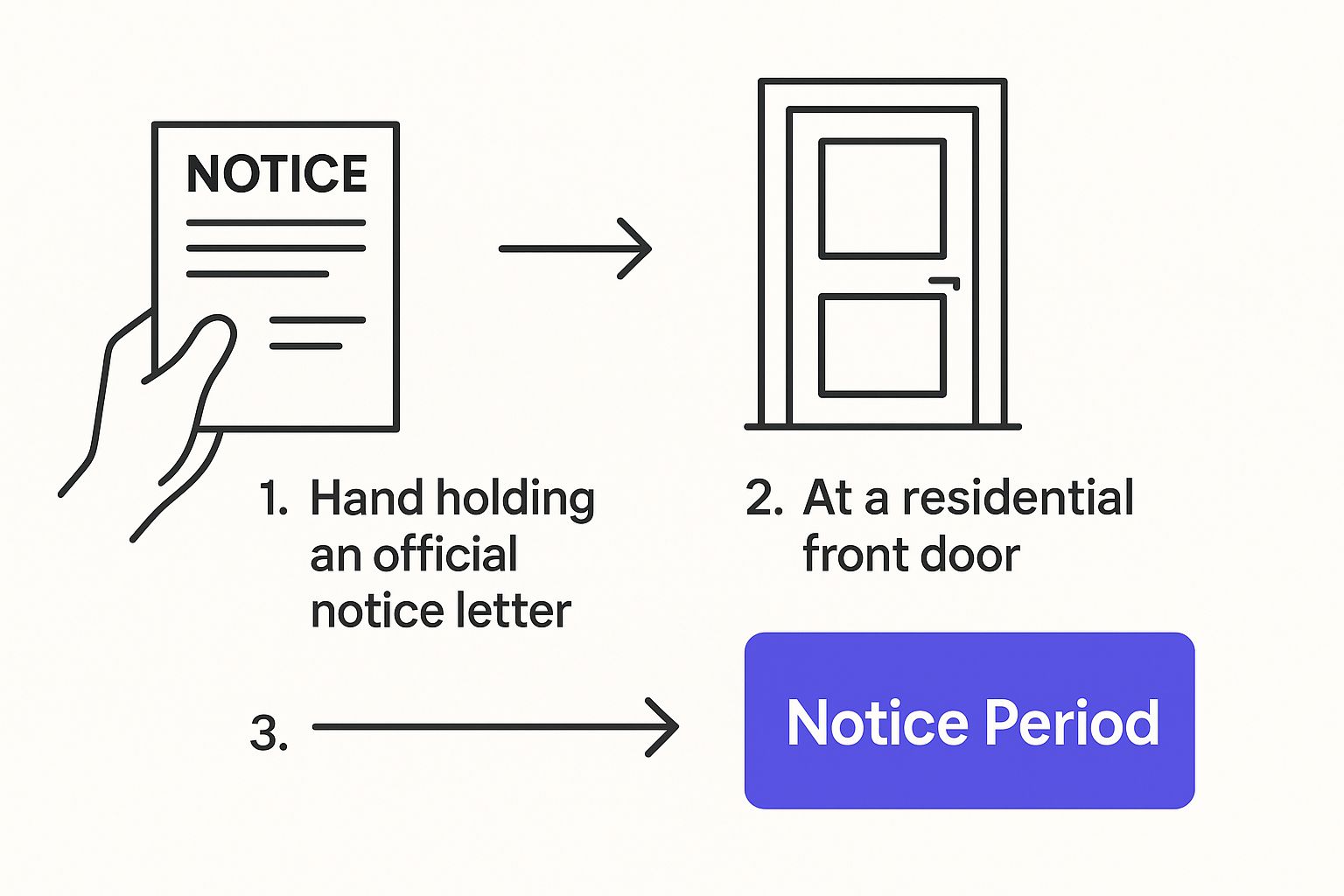
To get out of a lease smoothly, you have to do your homework. The process really boils down to three key things: digging into your lease agreement for the termination rules, giving your landlord proper written notice, and documenting the property’s condition so you get your security deposit back.
Whether it’s an apartment or a car lease, getting these steps right will save you from surprise fees and legal headaches down the road.
Start by Decoding Your Lease Agreement

Before you do anything else, grab your lease agreement. This document is the ultimate rulebook for ending your tenancy and holds all the answers you need to terminate the lease the right way. It’s easy to get lost in the legal jargon, but if you know what to look for, the whole thing becomes much less intimidating.
Think of it as your roadmap. Your job is to find the specific clauses that spell out the exact terms for your departure.
Pinpoint Crucial Termination Clauses
Your first mission is to find the section that talks about ending the lease. It might be under a heading like "Early Termination," "Lease Break," or "Surrender of Premises." These paragraphs will lay out the specific conditions, any potential fees, and how much notice you need to give.
For example, a lot of leases have a buyout clause. This is often the cleanest way out. It lets you pay a one-time fee—usually equal to one or two months' rent—to walk away with no further strings attached. Finding this gives you a predictable, straightforward exit plan.
Key Takeaway: Your lease isn't just a piece of paper; it’s a binding contract with built-in instructions for how to end it. Your power in this situation comes from knowing what you signed.
You'll also want to look for any language about subletting or lease assignment. A subletting clause could let you find a temporary tenant to cover your rent, while an assignment clause might allow you to transfer the lease to a new person entirely, freeing you from all future responsibilities.
Understanding these details is critical. When you're ready to dig in, you can learn more about what to look for in a lease agreement to make sure you don’t miss anything important. Ignoring the fine print is how small issues turn into big financial problems.
To help you get started, here’s a quick rundown of the clauses you should be looking for in your agreement and what they mean for you.
Key Lease Termination Clauses to Identify
| Clause Type | What It Means for You | Your Next Action |
|---|---|---|
| Early Termination/Buyout | A provision that lets you end the lease by paying a set fee. | Calculate the buyout cost and decide if it's a financially viable option for you. |
| Notice Period | The amount of advance written notice (30, 60, or 90 days) you must give before moving out. | Mark your calendar to ensure you provide notice within the required timeframe. |
| Subletting/Assignment | Clauses that may permit you to find a new tenant to take over your lease. | Check for any landlord approval requirements or restrictions on finding a new tenant. |
| Military Clause (SCRA) | Special protections for active-duty service members allowing them to break a lease for deployment. | If you're in the military, gather your official orders to present with your notice. |
Taking the time to locate and understand these specific sections in your lease will give you a clear picture of your options. It turns a stressful situation into a manageable, step-by-step process.
Knowing Your Legal Rights and Responsibilities
When you sign a lease, you're not just agreeing to the terms on that piece of paper. You're also entering a relationship governed by a whole set of landlord-tenant laws. Getting a handle on these rights and responsibilities is absolutely critical if you’re thinking about ending your lease, because the law can sometimes give you leverage you didn't know you had.
In certain situations, you actually have the legal right to break a lease without facing a penalty, no matter what the contract says. These are often called justifiable reasons, and they’re protected by state or even federal law. A classic example is for active-duty service members. Thanks to the Servicemembers Civil Relief Act (SCRA), they can legally terminate a lease if they get deployed or receive orders for a permanent change of station.
Valid Reasons for Termination
Beyond military orders, there are other legally protected reasons that might allow you to walk away.
- Uninhabitable Living Conditions: If your rental becomes unsafe or violates health codes—think serious mold, no heat in winter, or major structural problems—and the landlord won't fix it, you may be able to leave. This is sometimes called "constructive eviction," where the landlord has effectively forced you out by failing to provide a livable home.
- Landlord Harassment: Actions like your landlord repeatedly entering your apartment without notice or shutting off your utilities are not just annoying; they can be illegal. This kind of harassment can be grounds to void the lease.
Important Note: I have to be clear here. Wanting to move for a new job or because you found a better place, while totally understandable, typically doesn't give you the legal high ground to break a lease without consequences. In those cases, you'll need to go back to the buyout or subletting options we talked about earlier.
Understanding this distinction is the key. It completely changes how you should approach your landlord and helps you figure out what your financial risk really is. Walking into that conversation knowing the law is on your side is a game-changer.
At its core, the legal framework is built on mutual obligations. You promise to pay rent, and your landlord promises to provide a safe, habitable home. These mutual promises are a foundational part of any contract. If you want to dig a little deeper into the legal theory, you can learn more about what is a consideration and how it shapes these agreements.
Taking the time to assess your legal standing before you act will give you the confidence to move forward in the best way possible.
Exploring Your Early Termination Options
When life throws you a curveball, you might find yourself needing to get out of your lease early. It happens. Beyond what your contract explicitly says, there are a few practical ways you can negotiate a smooth exit. The trick is to know your options so you can pick the one that makes the most sense for you, both legally and financially.
One of the cleanest ways to go is negotiating a lease buyout. This is where you offer your landlord a lump sum—often equal to one or two months' rent—to mutually agree to end the lease. It’s a straightforward break. For example, if your rent is $2,000 a month, you could offer $4,000 to walk away free and clear. This gives the landlord cash in hand to cover the vacancy while they look for a new tenant.
Subletting vs. Lease Assignment
If a buyout isn't in the cards, you could try finding a replacement tenant yourself. But it's critical to understand the difference between subletting and assigning your lease, because they have very different outcomes for you.
- Subletting: You find someone to live in the space temporarily and pay you rent. The catch? You’re still the primary leaseholder. That means you are legally on the hook for any damages or missed payments.
- Lease Assignment: You find a new tenant who formally takes over your entire lease. Once the landlord vets and approves them, your name is off the agreement, and you are completely free of any future responsibility.
No matter which path you take, giving official notice is the non-negotiable first step.

As the image shows, putting your intentions in writing is foundational. Each termination strategy requires a slightly different game plan, and understanding the nuances will help you figure out how to best cancel the lease agreement.
How to Write an Effective Termination Notice
Your formal termination notice is the single most important document you'll create in this process. It’s not just a letter—it’s a legal record that clearly and officially states your intention to end your tenancy. Getting this part right is your best defense against future headaches and financial disputes.
The notice needs to be direct and to the point. This isn't the time or place for long-winded explanations or emotional appeals. Its only job is to communicate your decision in a way that aligns with your lease agreement. Keep the tone professional and the language crystal clear to avoid any chance of misinterpretation by your landlord.
Key Components of Your Notice
For your notice to be legally sound, it must include a few non-negotiable elements. Miss just one, and you could risk invalidating the whole thing. Precision is everything here.
Here’s exactly what to include:
- Your Full Name and Address: Make sure to list every tenant on the lease, along with the full property address, including your unit number.
- The Current Date: This is the date you are writing and sending the notice.
- A Clear Statement of Intent: Use direct language. Something like, "This letter serves as my formal notice to terminate my lease and vacate the premises." is perfect.
- The Specific Termination Date: State the exact day you will be moved out. Double-check that this date complies with the notice period required in your lease (e.g., 30 or 60 days).
- Your Forwarding Address: Tell your landlord where to send your security deposit.
Pro Tip: Always send your notice via certified mail with a return receipt. It costs a few extra dollars, but it gives you a legal receipt proving exactly when the landlord received your letter. This simple step shuts down any potential "I never got it" arguments down the road.
Why This Matters in a Growing Market
Following these formal steps is more important than ever as the leasing market gets bigger and more regulated. The finance lease industry has shot up by 76% globally over the past decade, with new business volume growing 5.7% in just one recent year.
As more assets are leased, the rules around termination naturally become stricter. You can learn more about the trends in the global leasing industry to see the bigger picture. In this increasingly formal environment, properly documenting your lease termination is your strongest protection.
Finalizing Your Move and Getting Your Deposit Back

Once your termination notice is in your landlord's hands, the real work begins. Your new mission is simple: get your full security deposit back. This last leg of your tenancy is all about careful documentation and acting professionally. Think of it as building your case to prevent any surprise deductions.
Before you even think about packing a single box, grab your phone and start recording. You need to become a bit of a detective in your own apartment. Take detailed photos and videos of every single room. Don't just get wide-angle shots; zoom in on the inside of the oven, the state of the carpets, and any scuffs or nail holes that were there before you. This visual proof is your absolute best defense if a landlord tries to charge you for normal wear and tear.
The Final Walkthrough and Handover
If at all possible, schedule a final walkthrough with your landlord or property manager. It’s always better to do this in person. Why? Because it gives you a chance to address any issues right then and there and get their verbal sign-off on the property's condition. It’s much tougher for them to claim damages later after they’ve walked through a clean, empty unit with you standing right there.
When you meet, make sure you hand over every single key you were ever given—don't forget the mailbox key, storage key, or any electronic fobs. Asking for a simple written receipt for the keys is a smart, final step to prove you've officially and completely moved out.
Key Takeaway: Remember, your security deposit isn't a tip for your landlord—it's your money. By law, they have a set window to return it (usually 14 to 30 days, depending on your state) or give you an itemized list explaining any deductions.
If you do get a list of charges in the mail, don’t just sigh and accept it. Pull out the photos and videos you took. If you see deductions for minor paint scuffs or for problems that existed when you moved in, you absolutely have the right to dispute those charges in writing.
This entire process, from giving notice to getting your deposit, isn't just a concern for renters. Managing lease terminations properly is a huge deal in commercial real estate, too. For massive real estate investment trusts, handling lease expirations effectively affects everything from their income stream to their overall financial leverage. You can get a sense of the high stakes by exploring how lease management influences corporate asset strategy.
Common Questions About Lease Termination
When it comes to ending a lease, it seems like everyone has the same worries. It’s a process that can feel murky, but once you get answers to a few key questions, you’ll be in a much better position to handle it smoothly. Let's dig into the issues that trip up most tenants.
One of the biggest concerns is always the money. Can a landlord really hit you with a fee just for wanting to leave early? Yes, but there's a huge "if" attached. They can only charge you an "early termination fee" or a "buyout fee" if that exact clause is spelled out in the lease you signed.
This fee is usually a set amount, often equal to one or two months' rent. If your lease is silent on the matter, you might be responsible for paying rent until a new tenant is found, so cracking open that contract is your first and most important move.
Your Most Pressing Questions Answered
So, what if you just decide to pack your bags and disappear without a word? It’s tempting when you're in a tough spot, but it’s a high-risk gamble that almost never pays off. Your landlord has every right to sue you for the entire remaining rent on your lease.
Beyond that, they can report the unpaid debt to credit bureaus—tanking your score—and you can kiss your security deposit goodbye. That negative rental history will follow you, making it incredibly difficult to find your next place.
Another common point of confusion is the difference between assigning your lease and subletting. They sound similar, but the legal implications are worlds apart.
- Lease Assignment: Think of this as a complete handoff. You find a new tenant to take your place, the landlord vets and approves them, and you are officially off the hook for any future rent or damages.
- Subletting: This is more like finding a temporary roommate. You find someone to cover the rent, but your name is still on the lease. If they trash the place or stop paying, that’s on you. You're still the one ultimately responsible.
Key Takeaway: There's no one-size-fits-all notice period. The timeline you need to follow—typically 30, 60, or 90 days—is determined by what's written in your lease. If your lease doesn't specify a timeframe, your local landlord-tenant laws will provide the legal minimum. No matter what, always, always give your notice in writing to create a paper trail.
Navigating lease agreements can be overwhelming, especially when you need clear answers fast. Legal Document Simplifier uses AI to instantly analyze your lease, highlighting key clauses, deadlines, and financial obligations so you can understand your options and terminate your lease with confidence. Simplify your legal documents today at https://legaldocumentsimplifier.com.